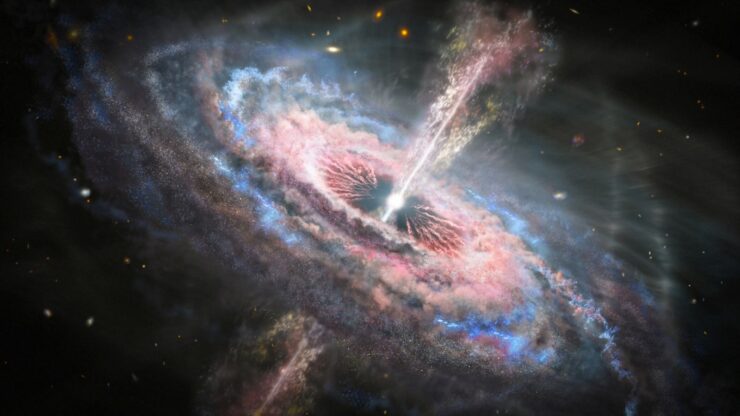The James Webb Space Telescope (JWST) has provided humanity with the deepest and clearest look into the cosmos yet. Among its most intriguing findings from the JWST Advanced Deep Extragalactic Survey (JADES) is an unexpected clue about the structure of the Universe. New evidence suggests that the rotation of distant galaxies is not random — a discovery that challenges long-standing cosmological principles and even raises the possibility that our Universe could exist inside a rotating black hole.
What did the James Webb Space Telescope reveal about galaxy spin directions?
In the JADES deep field, astronomers found a surprising imbalance: about 50% more galaxies rotate opposite to the Milky Way than in the same direction. This asymmetry is so striking that it can be noticed by eye, but it was confirmed with precise computer analysis.
Using an automated algorithm called Ganalyzer, researchers analyzed 263 spiral galaxies in the GOODS-S field. The results showed 105 galaxies rotating counterclockwise (same as the Milky Way) and 158 galaxies rotating clockwise (opposite direction). Statistically, this corresponds to 3.39σ significance, meaning the odds of this pattern occurring randomly are just 0.07%.
Have other telescopes also found galaxies spinning unevenly across the Universe?
Yes, the JWST findings strengthen earlier hints from ground-based observatories and the Hubble Space Telescope (HST). Surveys such as SDSS, Pan-STARRS, DES, and DESI all reported similar spin asymmetries, though less pronounced.
Crucially, those studies also found that the imbalance becomes more significant at higher redshifts (looking further back in time). JWST, which sees deeper than any telescope before it, confirmed and amplified this trend.
Interestingly, the strongest asymmetries have been observed near the Galactic poles. In the JADES field near the Southern Galactic Pole, clockwise-spinning galaxies are more common, while fields farther from the poles show weaker or no asymmetry.
Does the uneven spin of galaxies disprove the idea that the Universe is uniform in all directions?
For decades, cosmology has rested on the Cosmological Principle — the assumption that the Universe is isotropic (looks the same in every direction). But a large-scale spin preference would challenge this foundation.
The results suggest that the early Universe may have been more organized than expected, perhaps shaped by a cosmological-scale axis aligned with the Galactic poles. Several models could explain this, including:
- Ellipsoidal Universe models
- Dipole Big Bang theories
- Variations of isotropic inflation
- Rotating Universe theories
The last explanation is particularly compelling because it ties directly into black hole cosmology, the idea that our Universe might exist inside a larger rotating black hole.
Could Doppler effects or unknown physics explain why galaxy spins look uneven?
Not all scientists believe the asymmetry reflects the Universe’s structure. Another possibility is that it comes from how we observe galaxies.
Galaxies rotating opposite to the Milky Way could appear slightly brighter due to Doppler effects, making them easier to detect — especially near the Galactic poles. However, the brightness difference observed is stronger than current models predict.
This raises the possibility of new physics in galaxy rotation. Unexplained effects might influence not just brightness but also redshift measurements, connecting to larger cosmological puzzles such as:
- The Hubble tension (different measurements of the Universe’s expansion rate)
- The existence of massive, mature galaxies at very high redshifts
- The unsolved mystery of dark matter and alternative theories like modified Newtonian dynamics
If galaxy spin asymmetry is linked to unknown physics, it could reshape our understanding of both galaxy dynamics and the fabric of the Universe.
Is our Universe actually inside a spinning black hole?
One radical but increasingly discussed possibility is that our Universe resides within a rotating black hole in a larger “parent universe.” Black holes are known to spin, and if our cosmos were formed inside one, it would naturally inherit a preferred direction of rotation.
This idea fits with holographic cosmology (the Universe as a projection of deeper physics) and with theories of a fractal large-scale structure. Together, these alternative models challenge the conventional Big Bang narrative and offer potential explanations for other anomalies in modern cosmology.
What does galaxy spin asymmetry mean for the future of cosmology?
JWST’s discovery of a statistically significant asymmetry in galaxy rotation adds a new layer of mystery to our understanding of the cosmos. Whether this imbalance reflects a fundamental feature of the Universe or hidden physics of galaxy dynamics, it demands a rethinking of established models.
If the asymmetry indeed signals a rotating Universe within a black hole, it would be one of the most profound paradigm shifts in science reshaping not only cosmology but also our conception of reality itself.


















